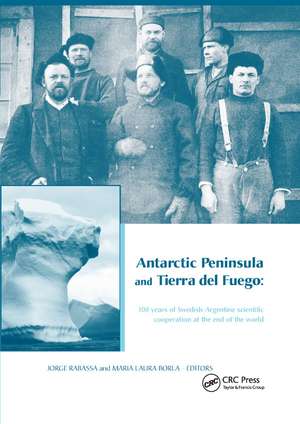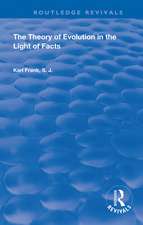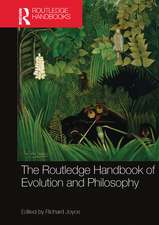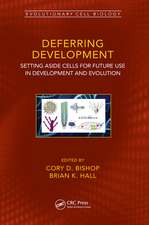Antarctic Peninsula & Tierra del Fuego: 100 years of Swedish-Argentine scientific cooperation at the end of the world: Proceedings of "Otto Nordensjold's Antarctic Expedition of 1901-1903 and Swedish Scientists in Patagonia: A Symposium", Buenos Aires, Argentina, March 2-7, 2003
Editat de Jorge Rabassa, Maria Laura Borlaen Limba Engleză Paperback – 9 aug 2018
The symposium and associated activities took place in the cities of Buenos Aires, La Plata and Ushuaia (Tierra del Fuego), and this book includes a selection of the most significant contributions presented at the meeting.
Preț: 369.82 lei
Preț vechi: 492.06 lei
-25% Nou
Puncte Express: 555
Preț estimativ în valută:
70.77€ • 74.41$ • 58.47£
70.77€ • 74.41$ • 58.47£
Carte tipărită la comandă
Livrare economică 17 aprilie-01 mai
Preluare comenzi: 021 569.72.76
Specificații
ISBN-13: 9781138381322
ISBN-10: 1138381322
Pagini: 214
Ilustrații: 84
Dimensiuni: 174 x 246 mm
Greutate: 0.43 kg
Ediția:1
Editura: CRC Press
Colecția CRC Press
ISBN-10: 1138381322
Pagini: 214
Ilustrații: 84
Dimensiuni: 174 x 246 mm
Greutate: 0.43 kg
Ediția:1
Editura: CRC Press
Colecția CRC Press
Public țintă
ProfessionalCuprins
Preface
Part 1. Natural History
Part 1. Natural History
- The work of Nordic geologists in Argentina
- Carl Caldenius and other links between the Nordenskjöld expedition and recent Argentine–Swedish cooperation in Quaternary geology
- Straddling the Drake Passage. A summary of Otto Nordenskjöld´s and his geological co-worker´s achievements in Patagonia, Tierra del Fuego and the Antarctic Peninsula
- Swedish glaciological work around the Weddell Sea during the last century
- Late Cretaceous-Early Tertiary marine and terrestrial vertebrates from James Ross Basin, Antarctic Peninsula: a review
- An appraisal of the report by Einar Lönnberg (1905) on fishes collected by the Swedish South Polar Expedition
- Botany during the Swedish Antarctic expedition 1901-1903
- Ozone and UV-B irradiances over Antarctica in the last decades
- Salt-marsh vegetation as biological indicator of increased solar UV-B radiation consequence of ozone global depletion.
- One hundred years ago: The Swedish Expedition to the South Pole (October 16th, 1901, Göteborg-December 2nd, 1903, Buenos Aires). Its scientific production and historical implications
- Pioneers of scientific cooperation. About memory, oblivion and representations of the past
- South Polar imaginations and geopolitical realities – Contextualising Otto Nordensjöld’s scientific internationalism and its limits
- Open horizons: A trek through Otto Nordenskjöld’s many landscapes
- Pemmican and penguin-breast, but no pie. Daily problems of Polar explorers during the Heroic Age of Antarctic exploration
- To remember and restore the Argentine rescuers of the Nordenskjöld Expedition 1901-1903
- Sea nomads of the Beagle Channel and surrounding areas
Notă biografică
Jorge Rabassa was born and educated in La Plata, Argentina where he got his degrees in Geology at the Faculty of Natural Sciences and Museum, University of La Plata. He did research on the Glacial Geology on James Ross Island, Antarctic Peninsula, between 1980 and 1982, in some of the same areas visited by the Nordenskjöld Expedition of 1901-1903. He has visited the Antarctic Peninsula several times on board of Antarctic Cruises as Lecturer. He is currently a Principal Investigator of CONICET at CADIC, Ushuaia, Tierra del Fuego, Argentina and a Professor of Geography at the University of Patagonia in Ushuaia. His main fields of interest are Quaternary Geology and Geomorphology of Patagonia and Tierra del Fuego.
María Laura Borla was born in Buenos Aires where she graduated in Tourism. Since 1986 she has worked as a nature-oriented guide in Tierra del Fuego and has traveled to Antarctica aboard A.R.A. Bahía Paraíso in 1987-1989, visiting some of the over-wintering areas where the Swedish-Argentine expedition took place. She has carried out research on Nature-Oriented Tourism and got a Master’s degree in this field and is the author of the book "Exploring Tierra del Fuego" (edited in Ushuaia in 2001, 2nd edition 2005), among other publications. She also works as a Spanish-English-French interpreter in Ushuaia.
María Laura Borla was born in Buenos Aires where she graduated in Tourism. Since 1986 she has worked as a nature-oriented guide in Tierra del Fuego and has traveled to Antarctica aboard A.R.A. Bahía Paraíso in 1987-1989, visiting some of the over-wintering areas where the Swedish-Argentine expedition took place. She has carried out research on Nature-Oriented Tourism and got a Master’s degree in this field and is the author of the book "Exploring Tierra del Fuego" (edited in Ushuaia in 2001, 2nd edition 2005), among other publications. She also works as a Spanish-English-French interpreter in Ushuaia.
Descriere
Selected contributions from the international symposium held in Argentina in March 2003, which commemorated the Nordenskjöld’s expedition, Swedish-Argentine early scientific fieldwork in Patagonia and Antarctica, and our current knowledge on the Archipelago of Tierra del Fuego, Antarctic Peninsula and the sub-Antarctic seas.





















